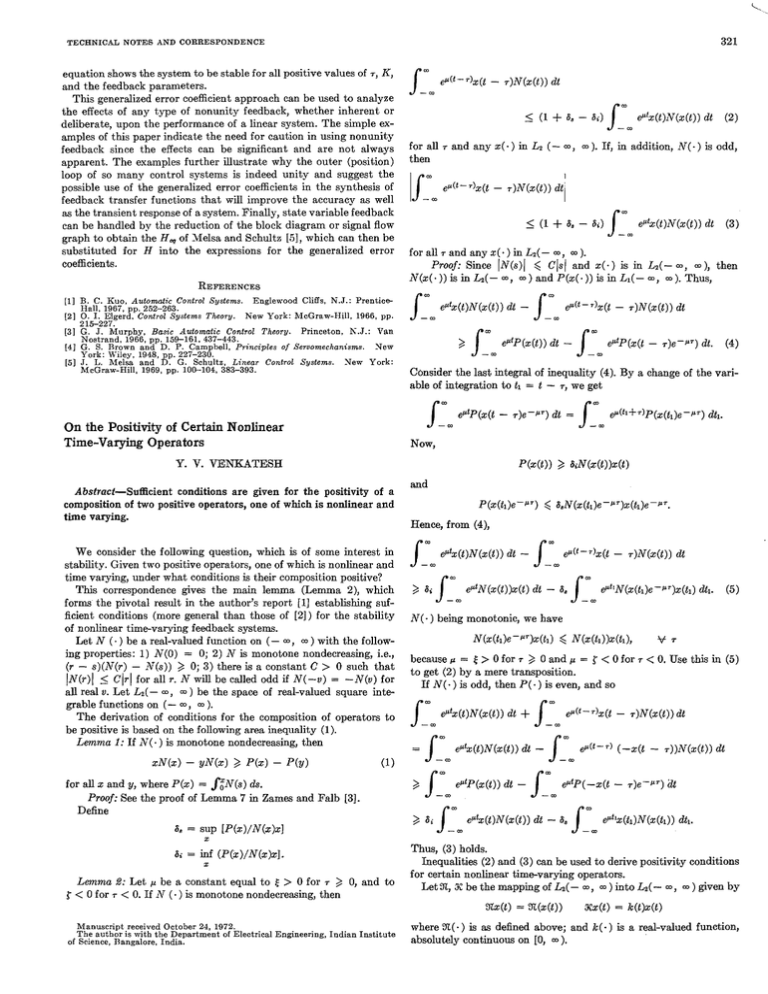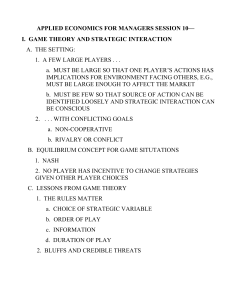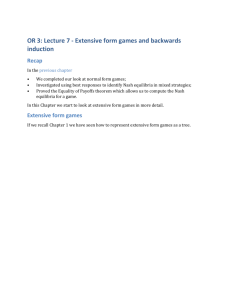s;m
advertisement

32 1 TECHNICALNOTES AND CORRESPONDENCE equation shows the system to be stable all for positive valuesof T, K , and thefeedback parameters. This generalized error coefficient approach can be used to analyze the effects of any t,ype of n0nunit.y feedback, whether inherent, or deliberate, upon t.he performance of a linear system. The simple examples of this paper indicate t.he need for caution in using nonunit,y feedback since the effects can be significant and are not always apparent. The examples further illustrat.e why the outer (position) loop of so many control systems is indeed unity and suggest the posible use of the generalized error coefficients in the synthesis of feedback transfer funct.ions that will improve the accuracy as well as the transientresponse of a system. Finally, stat.e variablefeedback can be handled by t.he reduct.ion of the block diagram or signal flow graph to obt.ain the H , of Melsa and Schultz [;I, which can then be substitutedfor H intothe expressions for the generalized error coefficients. < (1 for all then T + 6, and any z(.) in LZ (- s;m -a i) m, m). e"'z(t)X(z(t))dt (2) If, in addition, - V ( - ) is odd, REFERENCES (11 B. C. Kuo, Automdie Confrol Systems. EnglewoodCliffs,N.J.:PrenticeHall, 1 9 6 i pp. 252-263. [2] 0. I. Elgird. Control SystemsTheory. New York: IvIcGraw-Hill, 1966, pp. 215-227. [3] G. J. Murphy, BasicAutomatic Control Theory. Princet,on,K.J.:Van Nostrand, 1966, pp. 159-161, 437-443. [4] G. S. Brownand D . P. Campbell, Principles of Servomechanism. New York: Wiley, 1948, pp. 227-230. [5] J. L. Mel? and D . G. Schultz. Linear Control Systems. New York: McGraw-HI11, 1969, pp. 10&104, 383-393. pf m :f,, e t ) N ( ~ ( t dt )) - eO'P(z(t)) dt ep(t-r)z(t - - dt T)N(z(~)) e.fP(z(t - .)e-".) dt. (4) Consider the last integral of inequalit,y (4).By a change of the variable of integration to tl = t - 7, we get On the Positivity of Certain Nonlinear Time-Varying Operators Y. V. VENKATESH Abstract-Sufficient conditions are given for the positivity of a composition of two positive operators, one of which is nonlinear and time varying. We consider the following question, which is of some interest in stability. Given two positive operators, one of which is nonlinear and time varying, under what conditions is t,heir composition positive? This correspondence gives the main lemma (Lemma 2), which forms the pivot,al result in the author's report [l] establishing sufficient. conditions (more general t.han those of [2]) for the stability of nonlinear timevarying feedback systems. Let N (. ) be a real-valued funct.ion on (- m , m ) with the following properties: 1) X ( 0 ) = 0; 2) N is monotone nondecreasing, Le., (T - s ) ( N ( r )- -V(s)) 0; 3) there is aconstant C > 0 such that lN(r)l _< C(TIfor all T . N will be called odd if N ( - v ) = - N ( v ) for all real v. Let Lz(- m , m ) be the space of real-valued square integrable functions on (- m , m ). The derivat,ion of conditions for the composit.ion of operators to be positive is based on t.he following area inequality (1). Lemma 1: If lV(.) is monotone nondecreasing, t,hen z N ( z ) - yAT(z) 2 P ( z ) - P ( y ) (1) for all z and y, where P ( z ) = f i A r ( s )ds. Proof: See the proof of Lemma 7 in Zames and Falb [3]. Define sa = sup [P(z)/N(z)z] 2 6i = inf ( P ( z ) / N ( z ) z ] . Manuscript received October 1972. 24, The author is with the Department of Electrical Engineering, Indian Institute India. Bangalore, of Science, Thus, (3) holds. Inequalities (2) and (3) can be used t o derive positivity conditions where X(. ) is as defined above; and k absolutely continuous on [0, m ). (e ) is a real-valued function, 322 IEEE TRANSACTIONS ON AUTOMATIC CONTROL, .TUNE I. INTRODUCTIOS Let Lte be the space of real-valued functions x(. ) on t.he interval 03, m ), for which for every finite t 3 0, z ~ ( Td7) < a. Let.2 denote the class of operators 2:Lz, + Lb sat.isfying an equation of t,he type 1; (- 1973 The Shckelberg solut.ion [ l ] for a two-player nonzero-sum differential game where, because of a bias in the prior information sets, one player assumes the role of a leader and t.he other player assumes t.he role of a follower has been investigated in [2] and [3]. In this note m a t.he Stackelberg concept, isrridened t o include games where the number of players are more than t.m-0. The players are assumed to be divided into two groups, a group of leaders and a group of followers. z ( ~ ) z (t T ) dT r ( t ) (6) The group of leaders announce its st.rategies before the group of followers, and everyplayer may or may notbe cooperating wit.hin his where z;, zj’ (for all i, j ) are real constants; l(lzil izi‘l) < m ; own group. Naturally, in order t o be able t o define a Stackelberg st.rategy for this game, the leaders as a group are assumed t o know z ( . ) is a real-valued function on (- m , 03 ), and j? dr < m; the rationale according to which the followers are playing, and t,he 0 < 7 1 , 71’ < T Z , ~ 2 < ’ . . . . It is shown in [3] t.hat any convolution of followers are assumed t o be rat.iona1in the sense that. t.heg will play form (6) is a bounded linear transformation of L?(- =, m ) into itself according t o this rationale. Several interesting games can be f o m and that the set of all such convolutions can be vieaed as a con1mut.a- d a t e d using the above model such as, for example, oligopoly markets tive Banach algebra with an identity. where there are several large firm- as price leaders and several other Finally, let X be a given operatorin C. X is called posit.ive if smaller firms as price followers. JFz(t)m(t)dt 0 for all z in the domain of X and all T 0. In this note,preliminary results as a basis foramore general The lemma given below is proved (under somewhat, less general theory of a tao-group Stackelberg game are obtained. Because of its conditions) in [I]; its proof is based on inequalities (2) and (3). analytical simplicity, only the case where Nash strategies are the Lemma 3: The inequality rationale used withineach group is t.reated. Other cas- where minimax, Pareto, and Stackelberg st.rategies are used within each J T a(t)3?Yh(t)dt 3 0, doZ; t t T 2 0 ( i ) group can be similarly studied; however, this will not be done in this note. + + ~I-.(T)I > > where doz denotes t.he domain of Z, holds for all monotonely nondecreasing 37. if t,he following conditions are satisfied: 1) zi,zj’ 6 0 for i,j = 0,1,2,. . 2) Z ( T ) 6 0 almost everywhere; a ; where y , Y arenonnegativeconstants; 4) with f = nmx -( and = max Y for which 3) is verified, k ( t ) e - 8 is nonincreasing, and k(t)ecfis nondecreasing. The inequality (7) holds for all monotonically nondecreasing o d d X if conditions 3) and 4 ) are satisfied. 11. DEFIA-ITION AA-D PROPERTIES Let. S and ’11denote the number of players in groups 1 and 2, respectively, and let, Ci, i = 1, . *,a\r, and Vi, i = 1,. . . , X , be their U i and T’ = T ; : Vi be the sets of admissible controls. Let, C = ::T sets of admissible cont,rols for groups 1 and 2, respectively. Let J ~ ~ ( u.I. , u. . Y ; v I , - ..,s.u) Jji(u;v) (where u = (ul,. .,ux)EG and v = ( ~ ] , . . . , ~ . w ) E T ’ ) f o r j =l ; i = 1 , . - . , I \ : a n d j = 2 ; i = 1 , . - . , M , be t.he cost functions for the X M players, i.e., J i i : li X V + R for all j and i where j refers to t.he group, and i refers to the player in this group. Dqfinition 1: If there exist mappings Ti:T’ + Gi, i = l,.. -,N, such that. for any ~ € 1 ’ + ACKNOR-LEDGMENT The author wishes to thank Dr. 31. A . L. Thathachar for some useful discussions. REFERENCES [ l ] Y . V. Vykatesh. “Improved stability conditions for nonlinear time varying of Science.Uan~alore.India. systems.Dep.Elec.Eng.,IndianInstitute Rep. EE 124. June 1972. “?ioncausal multipliers for nonlinear system stability,” I E E E T r a n s . (21 Aufomrcl. Confr.. vol. XC-1.5. pp. 19.5-204. hpr. 1YiO. [3] G . Zames and P. Falh. “Stability conditions for sl-stems with monotone and slope restricted nonlinearities.” SI.4.V J . Cor.fr..vol. 6, pp. 89-108. 1968. -. A Stackelberg Solution for Games with Many Players M . SIhIXAN A N D J. B. CRUZ, J R . Abstract-The concept of Stackelbergsolution is widened to include games with many leaders and many followers. Necessary conditions for the existence of an open-loop Stackelberg solution in differential gameswhereeach player is usingaNash strategy within his group are also derived. 2 2 , 1973.This Jianuscript. receix-ed September 21, 1972;revisedJanuary work was supportedinpartby the T.S. Air ForceunderGrant.iFOSR-6& l579p. in part by the XSF underGrant GK-36276, and in part by the Joint Serrlces Electronics Prozram under Contract D.iAB-07-72-C-02.59. The authors arewith the Coordinated Science Laboratory and the Department of Electrical Engineering, University of Illinois, Urbana. Ill. 61801. where Tv = (7‘10,. .. , T x v )and if there exists a v,,EV such that J?i(TVs2;v,*) where v s J i ) = (oxm. 5 Jzi(TV,,c’);V*,c’)); i = 1,. * .,M . ., ~ ~ i - l ) ~ . , v i , ~ ~.i.+,V.W~:), ~ ) . ~ then the strategies (u,,,~,,)EC X V ahere uls: = T v ~ are , , called Stackelberg strategies with group 9 as -’ash leaders and group 1 as Sashfollowers. I n other words, this Stackelberg strategy is the optimal (in the sense of Nash) strategy for the leaders when the followers react by playingaccording t o a K s h optimalsolution. It protects every player in t,he leader group fromattempts by any other one player in the leader groupt o deviate from his Stackelberg strategy, causing the followers t o deviate also, in order t o furt,her reduce their costs. In this sense this St.ackelberg strat,egy is safer for theleaders than their corresponding Kash strategies, which in effect, safeguards everyplayer from attempts by anyone other player only to furtherreduce his cost. Following t,he same terminology as in [3], the Nash rationalreaction set of group 1 when group 2 is the leader group is defined by D1 = ((u,v)EC: X V :u = TU, YvEV). A similar definition can be made for the Nash rationalreaction set D2 of group 2 when group 1 is the leader group. It follows from the definitions of DI and D,that t.he Nash solution for the given game with 9 X players isobtained byt.aking the intersect,ion of D1 and + Dz. When : V = 1 the game reduces to a many-leader onefollower






